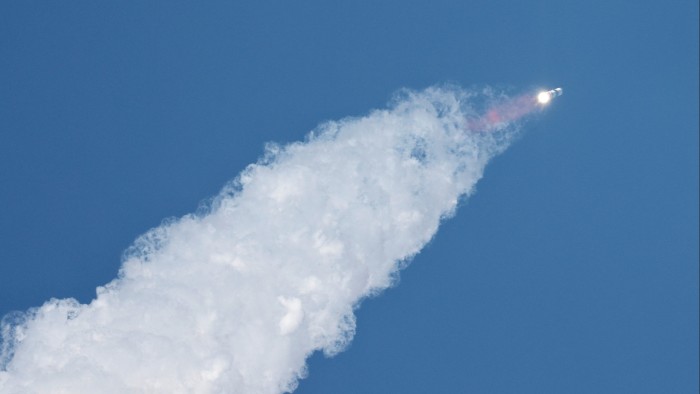Unlock the Editor’s Digest for free
Roula Khalaf, Editor of the FT, selects her favourite stories in this weekly newsletter.
SpaceX suffered another setback on Tuesday when its Starship rocket reached space, but failed to deploy its payload and part of the vehicle was lost on re-entry into the Earth’s atmosphere.
While the mammoth 400ft rocket was successfully propelled into sub-orbit from its Starbase in Texas, it was unable to deploy eight mock Starlink satellites. The loss of control of its upper stage over the Indian Ocean leaves SpaceX needing to undergo significant work to achieve its goal of manned flights to the Moon and Mars.
“Starship experienced a rapid unscheduled disassembly. Teams will continue to review data and work towards our next flight test,” SpaceX said in a statement.
SpaceX has previously flown Starship into space and managed to splash the vessel down into the ocean as planned. It has also caught the vessel’s reusable rocket booster stage in its giant “Mechazilla” robotic arms on its return to Earth.
The rocket maker said that it was pursuing a number of test objectives, including a steeper angle of re-entry with its booster rocket, that pushed the vehicle to its limits. It did not attempt to recover Starship’s lower stage, letting it crash land in the Gulf of Mexico.
“Leaks caused loss of main tank pressure during the coast and re-entry phase. Lot of good data to review,” SpaceX founder Elon Musk said in a post on social media site X.
The launch offered some relief to the billionaire. He has been under fire over claims he has grown distracted by politics. Musk, the largest donor to Donald Trump in 2024, has pledged to refocus on his various business interests including electric-car maker Tesla following pushback from shareholders.
Musk, who was scheduled to give an update late on Tuesday on the company’s plans to reach Mars, has previously said that SpaceX would launch its first uncrewed craft to the Red Planet next year with plans to send humans there by 2029. He plans to build a Martian city within two decades.
“Being multiplanetary will vastly increase the probable lifespan of consciousness, as we will no longer have all our eggs, literally and metabolically, on one planet,” Musk previously posted on X.
Nasa has contracted SpaceX to launch a crewed mission to the Moon using Starship no earlier than 2027 as part of its Artemis mission. A uncrewed launch is expected this year.
SpaceX reported that its failed January flight experienced a “rapid unscheduled disassembly” caused by a fire in its “attic” section. The explosion of its March flight stemmed from a fault in the vehicle’s upper stage engines.
On both occasions debris fell into the Atlantic Ocean over the Bahamas and Turks and Caicos Islands, while hundreds of flights departing from airports in Florida were grounded.
The Federal Aviation Administration had ordered SpaceX to pause launches following the incidents, but signed off on a further flight last week, stating that the company had “implemented all corrective actions”.
SpaceX has conducted more than 400 rocket launches since its inception, putting it far ahead of rivals including Jeff Bezos’s Blue Origin. It has achieved a steady run of launches with its Falcon 9 rockets and made successful attempts with its Falcon Heavy launch vehicle, but the much larger Starship rocket presents a greater technical challenge.
